Samsung Galaxy Note 2 Review (T-Mobile) - The Phablet Returns
by Brian Klug on October 24, 2012 9:00 AM ESTCellular
I talked earlier about the Note 2 being the first Samsung handset I know of to include MDM9x15. In the case of the T-Mobile Note 2 I was sampled, the device includes MDM9215 which is capable of category 3 LTE FDD and TDD, Release 9 DC-HSPA+, GSM/EDGE, and TD-SCDMA along with onboard gpsOneGen 8A GNSS. I’ve confirmed that MDM9215 is present without having to disassemble or otherwise tamper with the T-Mobile Galaxy Note 2.
One of the most interesting things about the Galaxy Note 2 on T-Mobile is that it literally is the same hardware as the AT&T Note 2 with LTE. Sure, the model number is different, but the T-Mobile Note 2 includes support for LTE bands 17 (which AT&T uses) and 4 (AWS, which AT&T has specced devices out for and T-Mobile has confirmed it will deploy LTE on). This is to my knowledge the first T-Mobile handset with overt LTE support, and thus a solid future-proof purchase if you’re determined to have a T-Mobile handset that will work with the carrier’s upcoming LTE on AWS plans.
In addition, if you unlock the handset there’s no reason it shouldn’t work on AT&T’s LTE network that I can see. I managed to unlock the T-Mobile Galaxy Note 2 but not before leaving the AT&T LTE market in Dallas. It does however work as expected on WCDMA 1900 in my own market on AT&T after unlocking.
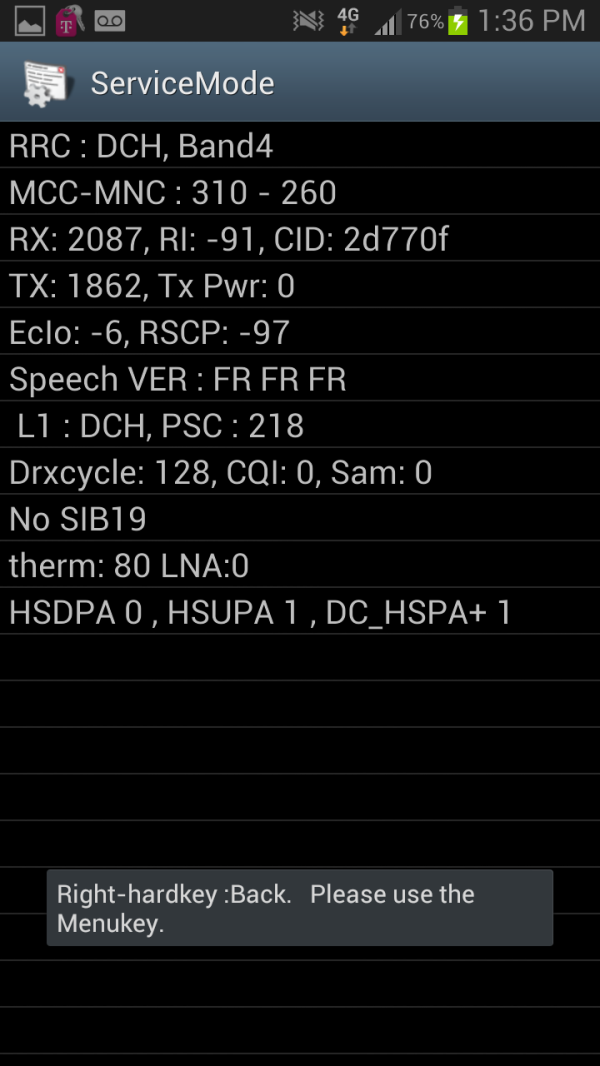
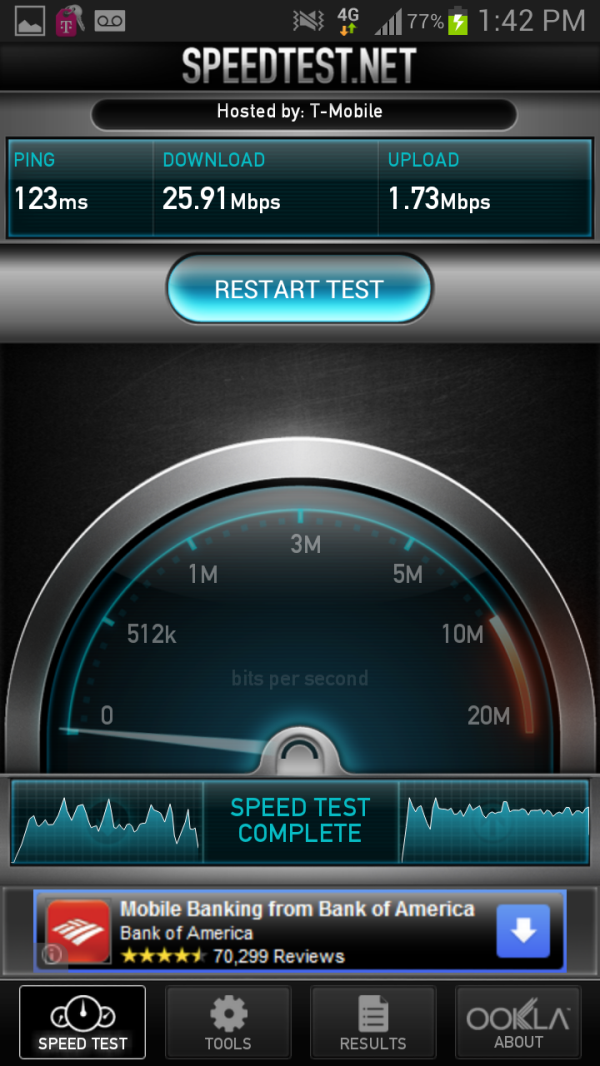
ServiceMode showing DC_HSPA+=1 (left), One of my fastest T-Mobile Tests (right)
As usual Samsung’s awesome ServiceMode is on the device and confirms that T-Mobile DC-HSPA+ is working. If you haven’t read discussion of DC-HSPA+ before, this is WCDMA carrier aggregation that combines two 5 MHz WCDMA downlink carriers, statistically multiplexes across them, and effectively doubles throughput on the downlink. That gets you from the theoretical maximum of 21.1 Mbps on 64QAM WCDMA up to 42 Mbps on dual carrier at the moment, which T-Mobile does run in its “4G” markets at present. I’m actually a huge fan of T-Mobile’s commitment to continually rolling out the latest physical layer upgrades for WCDMA and DC-HSPA+ keeps things feeling very speedy when you’re in good coverage and still helps at cell edge. Upstream is still limited to a single WCDMA uplink carrier, but most mobile traffic is so asymmetric to begin with it isn’t a huge deal.
| Galaxy Note 2 T-Mobile - Network Support | |||||
| GSM/EDGE Support | 850 / 900 / 1800 / 1900 MHz | ||||
| UMTS/WCDMA Support | 850 / 1700 / 1900 / 2100 MHz | ||||
| HSDPA/HSUPA Speeds | 42.2 Mbps (DC-HSPA+ Rel9) / 5.76 Mbps | ||||
| LTE Support | Band 17 (700 Lower B+C), 4 (AWS), UE Cat 3 FDD-LTE (Up to 100 Mbps DL) | ||||
| Baseband Hardware | Qualcomm MDM9215 (confirmed) + RTR8600 (?) | ||||
Interestingly enough ServiceMode has some hints about there being possibly even more bands, but these are probably for other Galaxy Note 2 variants based on MDM9215 that will pop up or have popped up for other locales.
Running speedtests and outputting the results on the Galaxy Note 2 is more of just a sanity check than something very interesting since we’ve seen dual carrier HSPA+ before. I had to test partially in Dallas, Texas during the Big Android BBQ and partially at home. For whatever reason the conference venue definitely had some T-Mobile propagation issues or loading from all the attendees, but the averages are still decent. I’ve seen speeds around 25 Mbps down on T-Mobile dual carrier HSPA+ which is pretty impressive honestly.
Stats Download Throughput (Mbps)Avg: 8.65, Max: 26.53, Min: 0.10, StDev: 5.60Stats Upload Throughput (Mbps)Avg: 1.49, Max: 3.56, Min: 0.01, StDev: 0.71Stats Latency (ms)Avg: 416.30, Max: 2394.00, Min: 57.00, StDev: 563.20
We see a weird double distribution of latency as well since there’s some additional setup and negotiation. I suspect getting out of PCH and into DCH results in some of this T-Mobile behavior when using speedtest.net, because tests without letting the radio go into IDLE have very low follow-up latency.
WiFi
The Note 2 uses BCM4334 for WiFi and is enabled for both 2.4 and 5 GHz. Just like the Galaxy S 3 that means 40 MHz channels on 5 GHz for a maximum physical layer speed of 150 Mbps. I did have some weird issues here, no matter what I did I couldn’t get the Note 2 to go on the 5 GHz AP, or get up to 150 Mbps.
Curiously enough there isn’t any 2.4 or 5 GHz priority toggle under the advanced tab in WiFi settings, yet the Galaxy S 3 models have this toggle and the same WiFi hardware stack. I suspect there’s some software or configuration issue here.
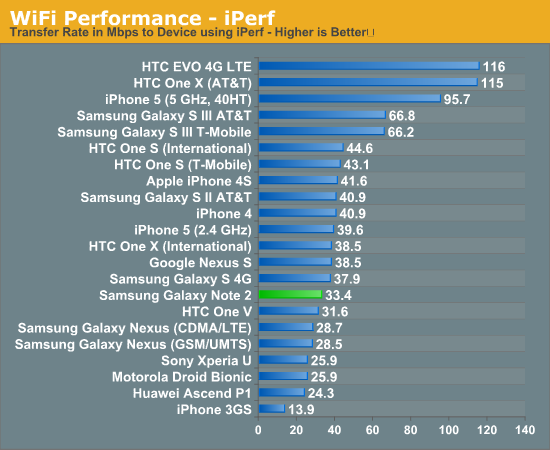
As a result we see iPerf performance out of the Galaxy Note 2 along the lines of what you’d expect for just 2.4 GHz operation. I’m puzzled as to why this is the case quite honestly.
GNSS
There’s not really too much to say about GNSS on the Galaxy Note 2 other than that like other MDM9x15 based handsets, it leverages Qualcomm’s on-baseband GpsOneGen 8A for both GPS and Russian GLONASS based positioning. Gen 8A includes better LTE coexistence and lower power consumption compared to 8. I tested GNSS and found that locks are speedy and accurate, as expected. I suspect that the days of Samsung phones shipping with flakey GPS are now well behind us.










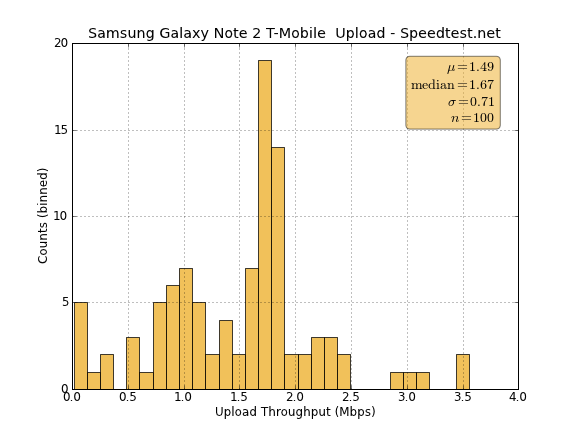
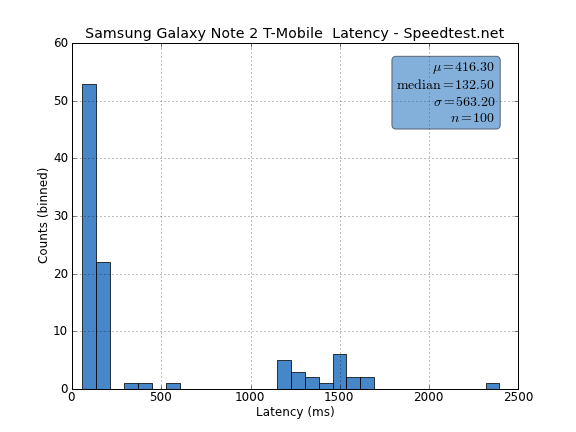
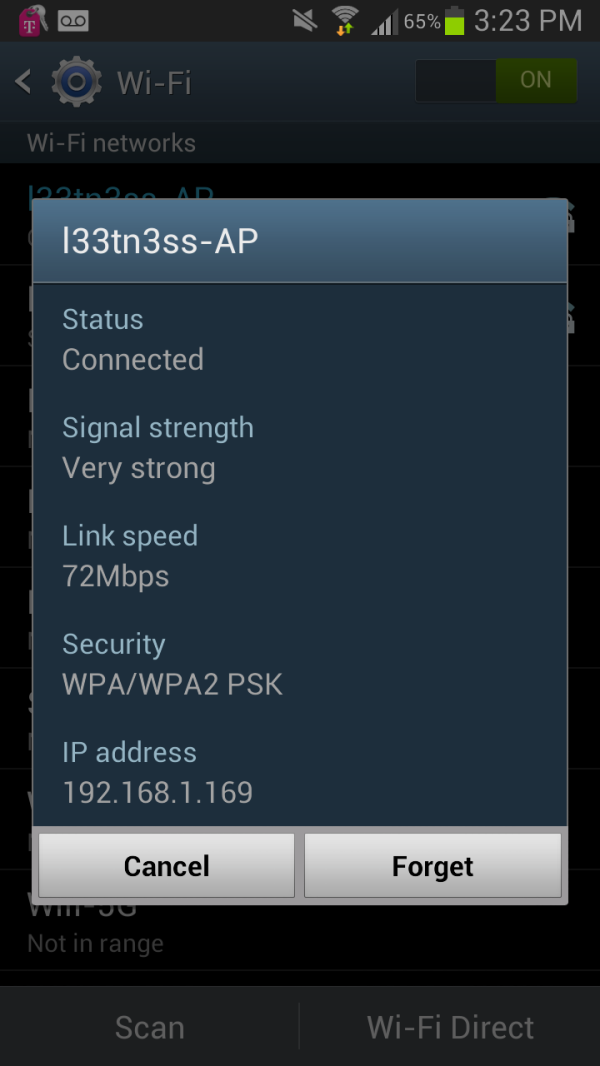
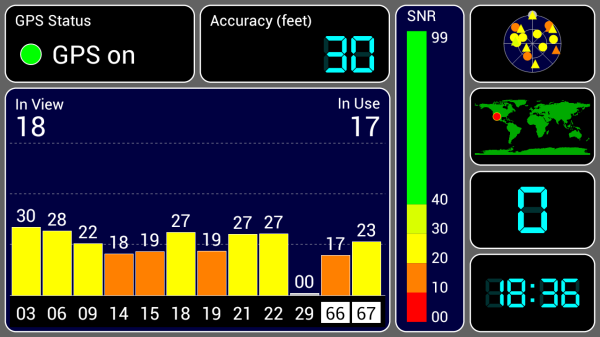








131 Comments
View All Comments
barry spock - Thursday, October 25, 2012 - link
The longer I spend think about my own subjective limitations, the more I realise that the products from anyone but apple aren't getting a fair go.And this one's an interesting product to attempt to not pigeonhole. I'd think of it more as a media device than a phone. And so does the rest of south korea, as I watch them using these things on the subway -- they watch tv on them. They make calls using earbuds -- not holding a thing this size to their heads. And they rarely put it in their pockets -- it goes in a handbag (or a manbag)
The bit about it not fitting in the F-150's "big Gulp" plastic cup holder speaks volumes about the culture it was written in.
Different cultures will use these devices differently. I imagine Samsung won't fret if this isn't taken up in droves in the US, because after all, there's always china.
Also, Anand, et al. *please* give us the ability to mod-down thoughtless comments such as the first one attached to this article.
CeriseCogburn - Friday, February 1, 2013 - link
Please give us the power to wipe out the idiots who are stupid enough to double post, as if their comments are better than others comments, and as if we need to see them.Paulman - Thursday, October 25, 2012 - link
"One of the biggest factors young tech reviewers like myself forget is that visual acuity does diminish with age as the crystalline lens loses its ability to flex and accommodate, thus reducing how close one can focus."Ha ha, this is an optical engineer's way of explaining that old(er) people need reading glasses :P I had to wikipedia this, but apparently the medical term is "Presbyopia" http://en.wikipedia.org/wiki/Presbyopia
Can't wait for the next episode of the Anandtech Podcast, Brian!
galaxynotetoo - Thursday, October 25, 2012 - link
Every feature that Galaxy Note 2 has, can be found in bigger screen tablets expect for the ability to make calls. The other big screens cost fraction of what Galaxy Note 2 costs. eg : 199 for Google Nexus, 329 for iPad mini. Why pay $700 for this crap Galaxy note 2 ?Visual - Thursday, October 25, 2012 - link
Firstly, the obvious thing - to make calls. Duh.Secondly, no, it's not every feature. Pressure sensitive active pen digitizer is not found on any other current ARM tablet, and is a serious plus for some applications, i.e. drawing or even just handwriting. There's a reason it is called Note.
Spunjji - Thursday, October 25, 2012 - link
You really created an account here just to say that? :|Miniaturisation doesn't come cheap. Fact is, though, they're probably taking decent margins on this too. We can thank Apple for setting up that pricing expectation and capitalism for making sure every other company follows suit.
VooDooAddict - Thursday, October 25, 2012 - link
Been the first phone I've been excited about hitting sprint since the Palm Pre.Soon as it's available it will be replacing the launch Pre I'm still using.
liffey - Thursday, October 25, 2012 - link
"Switching back and forth between the stylus and fingers for using the basic Android interactions is annoying"Um you do know that you can invoke the menu and back command with the S Pen, right? Hold the button and swipe left for "back", and swipe up for "menu" (while holding the button, of course).
996GT2 - Thursday, October 25, 2012 - link
iPhone 5 screen resolution is 1136 x 640, not 1136 x 960 as listed in the table.cokata - Thursday, October 25, 2012 - link
the razr i has been mentioned and benched here and in the ip5 review and at least on the cpu side of things it looks like the only good competition to the A6